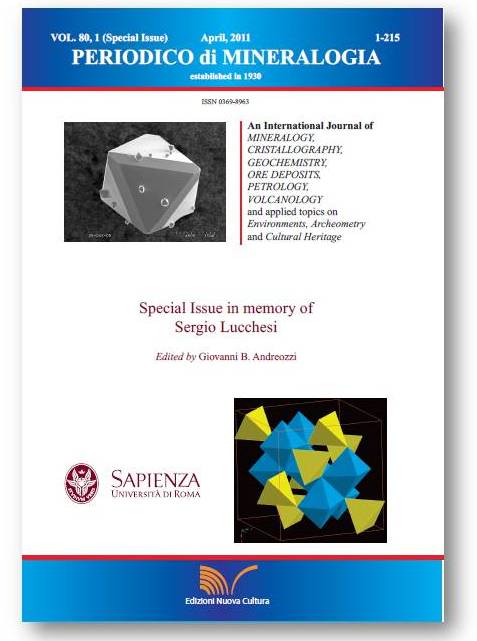The peculiar crystal-chemistry of phlogopite from metasomatized peridotites: evidence from laboratory and nature
DOI:
https://doi.org/10.2451/2011PM0015Keywords:
phlogopite, 10 phase, single crystal X-ray refinements, EMPA, SIMSAbstract
Periodico di Mineralogia (2011), 80, 1 (Special Issue), 181-197 - DOI: 10.2451/2011PM0015
Special Issue in memory of Sergio Lucchesi
The peculiar crystal-chemistry of phlogopite from metasomatized peridotites: evidence from laboratory and nature
Paola Comodi1,*, Sabrina Nazzareni1, Patrizia Fumagalli2 and Gian Carlo Capitani3
1Dipartimento di Scienze della Terra, Università di Perugia, Italy
2Dipartimento di Scienze della Terra, Università di Milano, Italy
3Dipartimento di Scienze Geologiche e Geotecnologie, Università di Milano Bicocca, Italy
*Corresponding author: comodip@unipg.it
Abstract
Experimental petrology suggested that phlogopite has a peculiar mineral chemistry at high pressure: excess of Si coupled with a decrease in IVAl and deficiency in K+Na. This K-edenite exchange, □XIISi(K+Na)-1Al-1, where □XII is a vacancy in the interlayer, should imply that phlogopites incorporate significant amount of talc component. At high pressure conditions, however, in a fluid saturated system, a talc component might translate into a 10 Å phase component, being the latter phase the product of the reaction talc + H2O = 10 Å phase occurring at P = 4 - 5 GPa and at T = 600-700 °C.
We aim to study the structure of natural and synthetic phlogopites showing this peculiar mineral chemistry. Samples were analysed by single-crystal X-ray diffraction, powder X-ray diffraction with full profile fitting, EMP, SIMS, TEM and Mössbauer spectroscopy. The natural samples were recovered from spinel and garnet wedge peridotites of the Ulten Zone Eastern Italian Alps, (Italy), whereas synthetic ones were obtained from high pressure synthesis in a K-doped lherzolite system. The single crystal X-ray refinements of natural phlogopites, together with the EMP analysis, showed two coupled substitutions: Tschermak (Si + Mg = IVAl + VIAl) and talc exchanges (□ + Si = K + Al), with no octahedral vacancies. The Rietveld refinement of the synthetic samples confirmed the ipersilicic character and K deficiency found with EMPA and SIMS analysis. The c lattice parameter of both synthetic and natural phlogopites positively correlates with the increase of vacancies at the interlayer site, pointing toward the c lattice parameter of the 10Å phase. The tetrahedral α rotation angle of natural phlogopites was about 9°, lower than that expected by Tscherma substitution. The present data indicate that the 10 Å phase component, instead of the talc component, stabilizes the phlogopite structure by reducing the α rotation under high pressure condition. This increases the pressure conditions needed to reach the upper limit value for the tetrahedral rotation.
Key words: phlogopite; 10 Å phase; single crystal X-ray refinements; EMPA; SIMS.


